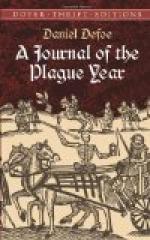The next bill was from the 23rd of May to the 30th, when the number of the plague was seventeen. But the burials in St Giles’s were fifty-three—a frightful number!—of whom they set down but nine of the plague; but on an examination more strictly by the justices of peace, and at the Lord Mayor’s request, it was found there were twenty more who were really dead of the plague in that parish, but had been set down of the spotted-fever or other distempers, besides others concealed.
But those were trifling things to what followed immediately after; for now the weather set in hot, and from the first week in June the infection spread in a dreadful manner, and the bills rose high; the articles of the fever, spotted-fever, and teeth began to swell; for all that could conceal their distempers did it, to prevent their neighbours shunning and refusing to converse with them, and also to prevent authority shutting up their houses; which, though it was not yet practised, yet was threatened, and people were extremely terrified at the thoughts of it.
The second week in June, the parish of St Giles, where still the weight of the infection lay, buried 120, whereof though the bills said but sixty-eight of the plague, everybody said there had been 100 at least, calculating it from the usual number of funerals in that parish, as above.
Till this week the city continued free, there having never any died, except that one Frenchman whom I mentioned before, within the whole ninety-seven parishes. Now there died four within the city, one in Wood Street, one in Fenchurch Street, and two in Crooked Lane. Southwark was entirely free, having not one yet died on that side of the water.




